Top News
September 15, 2012, Kazuki Furugen of Ryukyu Shimpo
From the 2013 fiscal year, the Okinawa Prefectural Government (OPG) will redouble its efforts to preserve Shimakutuba, the Okinawan language. The OPG has put together a ten-year plan for Shimakutuba in the second half of this year and will increase the current budget from 2 million to 20 million yen. Daiichi Hirata, the director general of the Department of Culture, Tourism and Sports of the OPG talked to the Ryukyu Shimpo ahead of the Day of Shimakutuba on September 18.
The languages of Okinawa are now recognized by UNESCO as being endangered. There is an increasing need to preserve these languages, with more people using them to help them spread and be passed on from one generation to the next.
In 2011, the OPG created the Department of Culture, Tourism and Sports as part of the restructuring of its organization. It has consolidated projects related to Shimakutuba and is holding meetings to which it invites university professors and other experts.
Hirata commented, “To mark 40 years since Okinawa’s reversion to Japanese sovereignty, we are celebrating this year as the departure year for Shimakutuba-related efforts.” He continued, “We will create a plan in the coming second half of the fiscal year, and work to give the plan shape. From next year we would like to launch a movement to familiarize people with Shimakutuba, in the same way as we have promoted the Good-job movement awareness-rising campaign (for a higher employment rate in Okinawa).” The basic plan will be formed later. However, Hirata said, “We would like to provide opportunities for people to have fun with Shimakutuba, while also studying it using an academic approach. The balance between the two is important. We will work on the project using our vision of how Shimakutuba would be used in the next five to ten years.” The Okinawa Prefectural Assembly added “the Day of Shimakutuba” to the prefectural calendar in 2006.
(English translation by T&CT, Kyoko Tadaoka and Mark Ealey)
Go to Japanese
September 20, 2012 Ryukyu Shimpo
Increasing numbers of Chinese, who planned travel to Okinawa, and Okinawans who had booked travel to China, have canceled trips due to protests in China against the Japanese government’s purchase of three of the disputed Senkaku Islands. Chinese organizations have canceled travel to Okinawa for meetings, performance rewards, conferences, and exhibitions and Okinawan prefectural high schools have canceled school trips to China planned for 2013. Various Chinese airlines have also decreased the number of flights between China and Okinawa.
According to a representative of the Okinawa branch of the Japan Association of Travel Agents, as of September 15, 314 groups and individual tourists from Shanghai, Beijing and Chongqing, Dalian and Hong Kong canceled trips to Okinawa. Forty tourists canceled trips on September 19. A total of 3279 tourists have canceled trips to Okinawa. At the same time, 52 Okinawan tourists canceled trips to Beijing and Dalian. On September 10, a total of 232 tourists canceled their travel plans to China. The China International Travel Service will also stop selling tickets for flights to Okinawa. The JCB International Credit Card Co., Ltd. planned to hold a convention inviting Chinese business partners during the period from September 26 to 29. Although the convention in Okinawa intended to invite 20 guests from China, including presidents of various allied banks in China, but 19 of them withdrew from the convention, which ended up being called off.
On September 19, the Okinawa Prefectural Yaeyama Commerce and Industry High School decided to change the destination of its school trip from China to another country.
Masaru Nakasone, assistant principal of the school, said, “We decided to make this change after considering the current situation in China. We want to decide on the destination after making sure that it will be safe, and after further studying the international situation.” The school group was scheduled to travel from Ishigaki via Naha to Beijing and Shanghai from March 9 to 13, 2013.
The situation has also affected airline companies. From September 20, China Eastern Airlines decreased the number of flights between China and Okinawa from 12 round trips with 24 flights a week to seven round trips with 14 flights. Hainan Airlines has suspended flights between Okinawa and Shanghai during the period from September 20 to October 27 and has not specified when they will resume the service. Juneyao Airlines postponed flights on September 20, but aim to resume their service from November 1. The company reported that more than 4000 tourists have canceled air-travel between Okinawa and China up to the end of October.
When asked about how these cancellations might influence the Okinawan economy, Junji Kamiya of the Exchange Promotion Division of the Okinawa Prefectural Government, said, “We want to examine the situation calmly. We will decide whether or not to create a task force after observing the situation in China for another week or so.”
(English translation by T&CT, Mark Ealey)
Go to Japanese
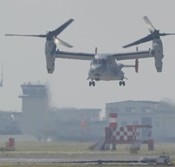
September 22, 2012 Kenyu Uchima of Ryukyu Shimpo
On September 21, at the Iwakuni base in Yamaguchi Prefecture, the U.S. Marine Corps began test flights of the MV-22 Osprey vertical take-off and landing transport aircraft. The MV-22 squadrons are staying temporarily in Iwakuni, before they move on to Futenma Air Station. These flights are the first for them in Japan. After completing the test flights, if possible, the Marine Corps plans to move the aircraft to the Futenma in several stages in October. The Marine Corps plans to have them fully operable in October within Okinawa, and then to send some of the MV-22s each month to Camp Fuji, in Gotemba, Shizuoka Prefecture, and to Iwakuni. They will carry out low-level flight training for the aircraft in Honshu, Shikoku and Kyushu.
The governments of Japan and the United States are moving to have full-scale operations start before the end of October despite a mass protest rally in Okinawa on September 9 and increasing calls to cancel the deployment to Futenma. Their hard-line approach can only further intensify the Okinawa people’s opposition to the deployment.
Seven MV-22s of the dozen aircraft in Iwakuni have conducted test flights. This was carried out in training airspace above the Sea of Japan, called “R134” which is off the coast of Shimonoseki, Yamaguchi. This airspace covers an area off the coast of Yamaguchi and Fukuoka. The Marine Corps says that it will avoid flying over land areas if possible, including when it moves the aircraft from Iwakuni to Okinawa.
The Marines carried out the test flights to check to see if the aircraft and its systems respond correctly to normal and abnormal situations during take-off and landing.
At 9:25am on September 21, one MV-22 took off from the Iwakuni base. The Marines conducted eight flights in total until 6:00pm that day. The MV-22 carried out hovering training within the grounds of the base.
In the morning, about 70 people belonging to citizen groups held a rally to protest against the test flights around the base, shouting and raising banners indicating their opposition to the deployment of the MV-22s.
(English translation by T&CT, Mark Ealey)
Go to Japanese
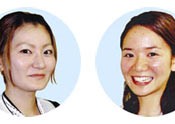
September 19, 2012 Kyoko Ishii Ryukyu Shimpo
Members of the Association of the Indigenous Peoples in the Ryukyus, Tomomi Ganeko and Reina Uema, will attend a meeting of the United Nation Human Rights Council to be held in Geneva from September 17 to 28. They will submit a written statement to the effect that U.S. bases in Okinawa have caused many incidents and accidents and their presence violates the human rights of locals. With regard to the Osprey aircraft deployment to Futenma Air Station, they will ask the Japanese government to respect the right of the Ryukyuan people for self-determination. They say that the government has allowed huge military bases to be established in Okinawa and that this is a mistake. The students want to convey their message to the whole world.
Many people from international NGOs and various government officials are represented on this council. In addition to letting people know about the crashes and the violent crimes by the U.S. military in the decades since the war, they will also report on the Osprey issue and the building of new bases at Henoko and Takae. It is the first time for the two students to attend the council meeting.
Ganiko, who is taking a course in Peace Studies at Keisen University Graduate School said, “Putting military bases in Okinawa like this reflects the discriminatory policy towards our people because it is a factor that has deprived us of our language and our culture through the years. I want to tell the next generation about what so many people before us have studied.”
Uema said, “Deploying the Osprey aircraft in Okinawa despite the many accidents it has been involved in is a violation of our human rights.” She hopes to share information with other participants from foreign countries.
(English translation by T&CT, Mark Ealey)
Go to Japanese
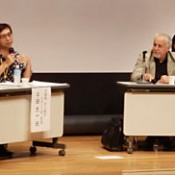
September 15, 2012 Ryukyu Shimpo
On September 14, at the Okinawa Prefectural Museum & Art Museum the International Content Business Symposium, “Globalizing Okinawan cultural content – Learning from Canada-Quebec how to promote local culture” was held to consider how to use Okinawan culture to create businesses.
Francois N. Macerola, the president and chief of SODEC (Software Development Expo), and Taichi Hirata, the director general of the Department of Culture, Tourism and Sports in the Okinawa Prefectural Government, discussed the possibility of commercializing Okinawan art and culture, and supporting the relevant structures around that. SODEC is a Quebec governmental organization founded to encourage the film industry to choose Quebec as a location for movie production. Marcerola said, “Okinawa should explore its identity and develop its own cultural business enterprises. Businesses should not only look to expand within the prefecture, but should also focus on opportunities in the main islands of Japan and in foreign markets,” emphasizing the need for cooperation in the public and private sectors, as well as the need for strong leadership.
Hirata also said, “Quebec is a role model for us. Okinawa needs to learn from their experience, and we need to change. Commercializing culture will be increasingly important in Okinawa.”
As part of the symposium, Yasuhisa Kazama, from the Okinawa Industrial Promotion Public Corporation, and Yuri Yoshimura-Gagnon, a film producer from Kukuru Vision, introduced case studies from Quebec.
The symposium was a pre-event of the “Bonjour Quebec Cinema Week in Okinawa” held from 15 to 17 September at the Ryukyu Shimpo Hall, in Izumisaki, Naha.
(English translation by T&CT, Kyoko Tadaoka and Mark Ealey)
Go to Japanese
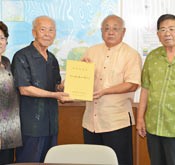
September 15, 2012 Ryukyu Shimpo
On September 11, members of the Irabu Branch of the Miyako City Senior Club visited Mayor Toshihiko Shimoji at the Miyako-jima Municipal Office in Hirara and presented him with a compilation of Irabu dialects, Irabu panali and sumautsu: Indigenous people’s life and language.
It covers the four languages that were spoken in the four communities of Irabu, Kuninaka, Sawada, and Sarahama. The former head of the branch, Genshin Nakasone served as a chief editor, and members from each district assisted with the editing. The compilation includes words related to body parts, plants, animals, foods, agricultural work, fisheries, and culture. For example, family is “yaade” in Irabu, “yaaji” in Kuninaka, “yaapito” in Sawada, and “yaaninju” in Sarahama. Each district has a different way of saying the same word. Also at the end of a book, there is a list of the place names on Irabu Island and Shimoji Island and the lyrics of each district’s youth club song are included.
Nakasone says, “Because each district has different dialects and customs, it was impossible to do all of the editing by myself.” Mayor Shimoji praised them for their hard work. The branch put together approximately 70 books and Mayor Shimoji said, “I want to make these accessible to people to read in libraries.”
(English translation by T&CT, Megumi Chibana and Mark Ealey)
Go to Japanese

September 1, 2012 Ryukyu Shimpo
On September 1, at Tancha in Onna, the Okinawa Institute of Science and Technology (OIST) celebrated its official opening. It was established in order to contribute to the promotion of Okinawa’s self-sustaining development as well as to the advancement of world-class science and technology. Operations started from September 3 and on September 6 the enrollment ceremony took place for a total of 34 students from 18 countries. Classes start from September 10.
The cross-disciplinary research areas are divided into the five major subjects areas of Molecular, Cell and Developmental Biology, Mathematical and Computational Sciences, Environmental and Ecological Sciences, Physics and Chemistry. The OIST aims to become a center of global network of scientists, and industrializing the fruits of research findings by cooperating with other leading edge research institutions and businesses.
The OIST has approximately 260 researchers, including 120 from overseas. They are involved in the most advanced scientific research in the world. The OIST offers integrated five-year doctoral programs with a single unified interdisciplinary approach. The research programs will be carried out in English.
(English translation by T&CT, Kyoko Tadaoka and Mark Ealey)
Go to Japanese
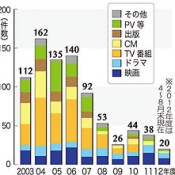
September 8, 2012 Wu Li Jun Ryukyu Shimpo
From 2003 to the end of August 2012, the Okinawa Film Office supported the filming of a total of 822 projects. This includes subsidizing the cost of the production of the Japanese-Canadian movie Karakara, which won the Public Award for the most popular Canadian feature film and the Openness to the World Award at the 36th Montreal World Film Festival. While the film office has achieved satisfactory results, it has still many problems to resolve. Overseas film crews face problems such as complicated procedures to get permission to shoot, and there is a lack of capable interpreters.
The film office has supported 131 movies, 85 dramas, 245 television programs, 126 commercials, 67 publications such as books and magazines, 120 promotional videos and 48 other works. This includes eight foreign movies and dramas.
In addition to Karakara, the Okinawa Film Office supported the filming of Nada Sousou, Dr. Koto’s Clinic 2006, and the Korean movie Ikemen desu ne. It supported more than 100 projects each year until 2006. Since 2008, it has narrowed down the scope of projects it supports because of pressure to reduce the Okinawa Prefectural Government’s budget, and because some people are starting to worry that the Okinawan private sector may be squeezed. Since 2011, the film office has specialized in supporting films and dramas. According to the office, while the number of projects it has supported has decreased, because the film crews stay longer, the direct economic benefit has grown.
Since fiscal 2010, in order to attract foreign film crews the Okinawa Prefectural Government (OPG) has provided subsidy support for the overseas content business. The OPG assists with a portion of the production costs, and Kukuru Vision Inc., which produced Karakara, received a 10 million yen grant from the OPG.
However, Okinawa is not ready to cope with large-scale overseas film crews. It needs larger numbers of interpreters and the various procedures for foreign film crews must be simplified. A staff member for the Okinawa Film Office pointed out that in addition to monetary assistance, they need a specific district or zone in which the proceedings to get permission of shooting are deregulated. They suggested that the OPG should also strengthen its efforts to support this project for industrial development, not only in order to promote tourism.
The Okinawa Film Office is located within the Okinawa Convention & Visitors Bureau. It works on the coordination of proceedings of shooting for film crews and seeks to attract overseas movies and dramas.
(English translation by T&CT, Mark Ealey)
Go to Japanese
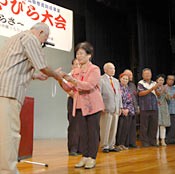
September 10, 2012 Ryukyu Shimpo
On September 9, at the Ryukyu Shimpo Hall in Izumisaki, Naha, the Shimajima nu Kutuba Katayabira Taikai was held by speakers from six regions. The event was hosted by the Naha Cultural Association and was co-hosted by the Okinawa Language Dissemination Association, the Okinawa Prefectural Uchinaguchi Association, Radio Okinawa, and Ryukyu Shimpo. Eleven participants from communities on the main island of Okinawa and the neighboring islands gave speeches in their local languages.
This was held as a pre-event to celebrate the 20th anniversary of the founding of Naha Cultural Association and the 120th anniversary of the establishment of the Ryukyu Shimpo, and was planned with assistance from the Naha Community Development Division. More than 400 people came to listen to the unique speeches delivered with a sense of culture from communities in places such as Okinawa Island, Miyako, Yaeyama, and Tokunoshima.
In his speech, Kota Agarie from Izena Junior High School said in his local language, “I want to be like King Shoen (who was from Izena Island).” After his speech, he said, “The number of Izena language speakers is decreasing. I want to be able talk to my grandma and to learn more of the language.” Agarie also went on to say how he was impressed with the impact of the Miyako language.
(English translation by T&CT, Megumi Chibana and Mark Ealey)
Go to Japanese
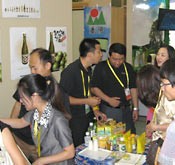
September 18, 2012 Ryukyu Shimpo
Fourteen Okinawan companies and organizations took part in the 16th China International Fair for Investment and Trade held in Xiamen, Fujian, from September 8 to 11. According to the Okinawa Industrial Promotion Public Corporation, the deals organized by the companies during the four days will be worth a total of about 120 million yen. During the fair, they had 428 opportunities to carry out sales talks and entered into 20 contracts with 184 contracts to be sealed within a year. There were 102 applicants seeking to work as agents for the Okinawan companies. The Okinawa Industrial Promotion Public Corporation, which served as the executive office for the Okinawan business meetings carried out a survey.
Neo-Planning and STTA Planning of Naha, Chang Taiyang Agriculture of Fujian, and Okinawa Tokusan Hanbai of Tomigusuku, have attracted many business inquiries, including prospective future buyers. Neo-Planning presented products such as sheets and a negative ion mattress. STTA Planning put designs and interior décor on exhibition. Changle Tai yang Agriculture Co. LTD displayed a Japanese-style model room using shoji screens and tatami. Okinawa Tokusan Hanbai arranged for sale of Okinawa specialty foods such as vegetable chips, shikwasa beverage, brown sugar and ginger powder. There were many inquiries from the visitors, including the exchange of information.
Takeo Tsuda, a chief adviser of the Okinawa Industrial Promotion Public Corporation, said, “Many visitors, including tourists and local people, came to the Okinawa Booth because of its location in the center of the venue. We have performed better than expected with an estimated 120 million yen worth of deals.” He said, “We want to follow up on these projects so contracts and negotiations work out well.”
(English translation by T&CT, Mark Ealey)
Go to Japanese
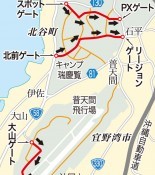
September 13, 2012 Ryukyu Shimpo
On September 12, at an evacuation drill explanatory session held in Camp Foster, a representative of the U.S. Marines in Okinawa stated that in the case of a tsunami, the Corps will allow local Okinawans to pass through the bases on foot via three approaches accessible from Route 58 adjacent to Camp Foster and U.S. Marine Corps Air Station Futenma. Colonel Dan Dowse, the director for operations and training on Marine Corps Bases in Okinawa said, “The door will be open to support the local residents for the rapid evacuation.” Following the Great East Japan Earthquake, municipalities in Okinawa asked the U.S. military to allow locals to pass through the bases in case of a tsunami.
U.S. military forces will permit Okinawan citizens to pass through Futenma Air Station from Oyama Gate to Samashita Gate, through Camp Foster from Kitame Gate to Legion Gate, and from Spot Gate to PX Gate. They are discussing evacuation routes through Camp Kinser in Urasoe.
That same day, the Marine Corps invited about 70 Okinawan citizens to Camp Foster, and conducted an evacuation drill in which the participants walked the evacuation route through Camp Foster from Kitame Gate to Legion Gate.
The Ginowan Municipal Government, Futenma Air Station and Camp Foster are discussing the process for concluding an agreement to allow local Okinawan people to pass through the bases in the case of natural disasters.
Dowse said that it would be possible to allow Okinawa people access through the bases from today if earthquakes occur and evacuation is needed. Colonel Katherine Estes, Headquarters and Service Battalion Commanding Officer of Camp Foster, said, “The gates will be open at the time of the warning signal, even before the official agreement is signed.” They have asked the Japanese government to convey tsunami warnings to them as quickly as possible.
Ginowan Mayor Atsushi Sakima voiced his appreciation, saying, “It is very significant.” U.S. military forces will allow Okinawan citizens to pass through the bases only on foot for evacuation purposes due to concerns over traffic congestion and accidents but the municipal governments intend to request to the U.S. military that they allow vehicles to pass through the bases, and let Okinawan people take refuge on the bases.
(English translation by T&CT, Mark Ealey)
Go to Japanese









 Webcam(Kokusai Street)
Webcam(Kokusai Street)


